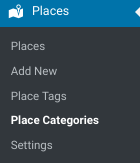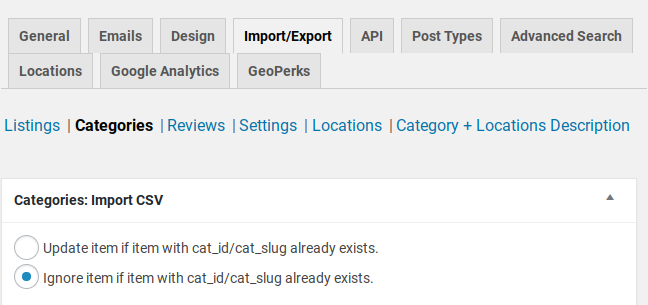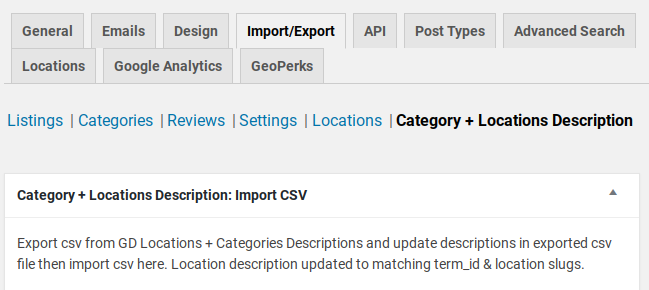Place Categories Update
Introduction
Need to know
Settings
Category+Location
Design
Support
FAQ – Frequently Asked Questions
Introduction
Each Custom Post Types has unique categories to group listings within that CPT.
What you need to know
- Every listing requires a category.
- Every category requires a map icon.
- The default category determines which map icon is shown on the map.
- Categories should be created before adding or importing listings.
- “Uncategorized” category is created with each new CPT. Delete it and add your own.
Category Settings
Find the Categories for the CPT like so:
Add or Edit a category to see the options below:
Default Category
The default category determines which map icon is shown.
Use either multiselect or checkbox field “Category display type” to let listing owners select a default category; otherwise the first/only category will automatically be set as the default.
Multiselect with default category
Checkbox with default category
Import and Export Categories
- Import and Export new and existing categories at GeoDirectory – Settings – Import/Export (Tab) – Categories
- When importing categories the default category must also be listed in the post_category column.
- After you import categories you should run the GD Term Count tool. This tool will update category counts. The tool can be found at:
GeoDirectory – Status – Tools (Tab) – Term Counts – Run
Category Archive Link Settings
Use Location Manager addon options to add or remove location from your archive URLs: https://wpgeodirectory.com/docs-v2/addons/location-manager/#url
Category Select with Advanced Search Addon
Add a category select field to the search bar with the Advanced Search Addon: https://wpgeodirectory.com/docs-v2/addons/advanced-search/#select
Personalize
Display category links on your site with the gd_categories https://wpgeodirectory.com/docs-v2/geodirectory/design-elements/#gd_categories
Display the category description field value on archive pages with gd_category_description: https://wpgeodirectory.com/docs-v2/geodirectory/design-elements/#gd_category_description
Customize
Increase the max categories per CPT: https://wpgeodirectory.com/support/topic/soft-maximum-for-categories-per-company/#post-493949
Get Support
Get support on our forum, fnd out more here: https://wpgeodirectory.com/docs-v2/v2/support/
FAQ – Frequently Asked Questions
Why doesn’t the Category+Country description show on the Category+Region or Category+City page?
There are fields for each, and only the specific field is shown on the matching frontend page.
For example, if the “Awesome” category + country=Netherlands is filled out, this will only show on the page for “Awesome” + “Netherlands” at a URL like: /places/netherlands/category/awesome
See more examples in the image above.
How to change the category “Uncategorized”?
You can edit or delete the category. Make sure that all your listings have another category assigned, first, so that you don’t end up with listings without a category. Listings without a category can break the map display and have other unintended consequences.
Here are some links to map icon resources:
http://mapicons.nicolasmollet.com/
http://www.smashingmagazine.com/2014/12/23/freebie-tourism-travel-icon-set-100-icons-png-svg/
https://mapicons.mapsmarker.com/category/markers/stores/apparel/
You can download the original markers that ship with GeoDirectory V1 including a PSD template here.
Interested in custom map markers and icons? Contact GD Experts: https://geodirectoryexperts.com
Changes in V2
Parent category selection
V2 does not automatically select a parent category when a child category has been selected. There is no way to force this behavior at the time of writing.
What else should I know about categories?
- Category Default Image, Category Font Awesome Icon, and Color are optional, but they are used by common GeoDirectory features and it is recommended to fill out each of them.
- If one CPT “Restaurants” has a category “general”, then a second CPT “Hotels” with a category “general” will automatically be assigned a slug pf “general-1” because all slugs must be unique all throughout the site.
- Categories and most category data can be imported and exported.
- SEO Note – One of the most powerful features of WordPress is the creation of Archive pages that are Category specific. GeoDirectory increases this power by creating archive pages for each Category + each Location. Read more about how to make the most of this unique and incredibly powerful feature for your site.
Can I use the same category in 2 different CPTs?
Categories from one CPT cannot be used to group listings from a different CPT.
Building a Unique Directory Step by Step
When you take your first steps to setup your new directory, the first thing you should do is create the categories you need, but in order to do that, you will at least need one map icon. When you first create your categories, you can set each to have the same icon. That is the easy thing to do, and you can come back later to create unique icons.
After you have created your categories, you can take the next step and find unique icons for each of your categories, and use a color that will make them distinct on your map or choose a color that will match the overall colors of your site.
Once you have a unique map icon for each category, next choose the appropriate Font Awesome Icon and color for each category to match your Map Icon.
When the Icons and colors are in place, you can use the gd_categories element on your front or Archive page or Location or Search page to show pretty links to all your category and category+location Archive pages.
Before you start adding a lot of listings to the categories, consider creating a unique default image for each category. The default image will ‘fill out’ the GD Detail page so your listings will be colorful and have visual content. Recommended 900px*600px or 3:2 aspect ratio.
Once you have these basic settings in place, you can proceed to adding the Category Top Descriptions and Category + Locations Descriptions.
As soon as you have the default Category Top Description in place for each category, consider adding the gd_category_description element to the Archive page template to display your category descriptions. As you go along, you can consider adjusting your layout so you can add videos, images, or other rich media to the Category Description field to make each Archive page unique.
What about default categories again?
Default Category
Every listing can have a default category. The default category is the listing’s “main category” in the sense that the default category is used to determine which Map Icon, Category Icon, Category Color, and Category Default Image are used for the listing.
When importing and exporting categories, check to make sure that whatever default category is chosen is also listed in the post_category column. It is not possible to select a default category without first selecting the category, meaning that the listing default category must also be a listing category.
In the frontend, you can use either multiselect or checkbox field “Category display type” to allow your visitors to select a default category. If they do not select a default category, eg cannot select a default category, it is probably because the field has been set to use select or radio. Change the Category display type back to multiselect or checkbox to allow users to set the default category.
Multiselect with default category
Checkbox with default category
Category+Location
After a category has been created, you can edit the category to add/edit the Category Top Description Field. The field is ‘rich text’ and accepts Media and HTML, making it easy to add pretty, unique descriptions of each category to each category Archive page with the gd_category_description element.
Here is some sample content:
On this page you can find all our listings that are labeled with {page category} and %%in_location%%Now that the default Category Top Description for a Category is in place, you can proceed to enter Category Top Description + Location for each location in your site database.
- Choose a category, and choose edit
- Scroll down to find the option “Category Top Description” and UNCHECK
- The Default Category Top Description field will be hidden.
- Proceed to fill in the unique category description for each location in your database
- Any Category+Location descriptions that are left blank will use the default Category+Description field value
For each of the Category + Location options, you can choose from all of the locations in your locations database on your site.
Category + Country Description
- Choose a country from your locations
- Add media and text to describe the country
Category + Region Description
- Choose a region from your locations
- Add media and text to describe the country
Category + City Description
- Choose a city from your locations
- Add media and text to describe the country
Import and Export Category Descriptions
Category+Location Values have a special export/import page, as shown here:







